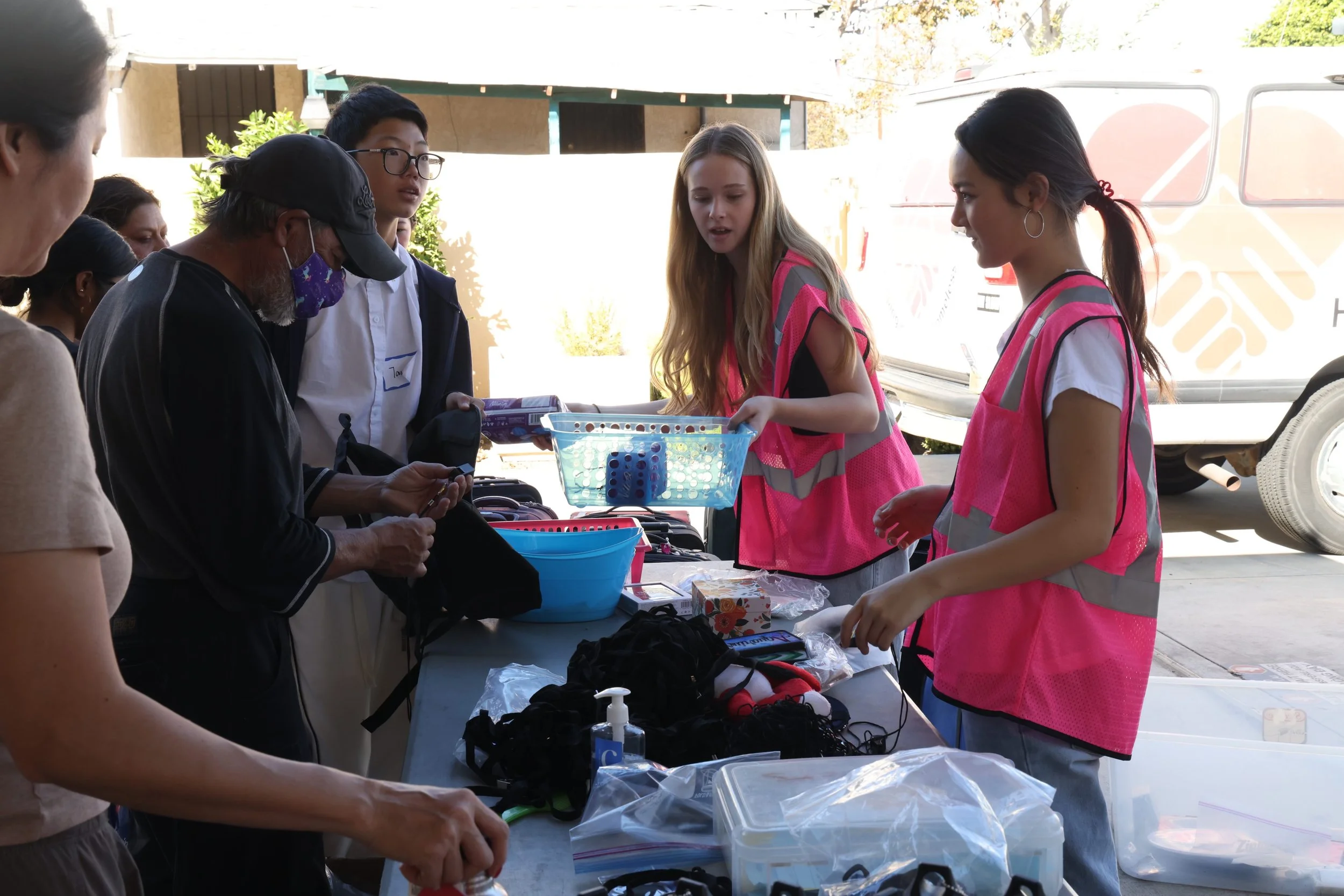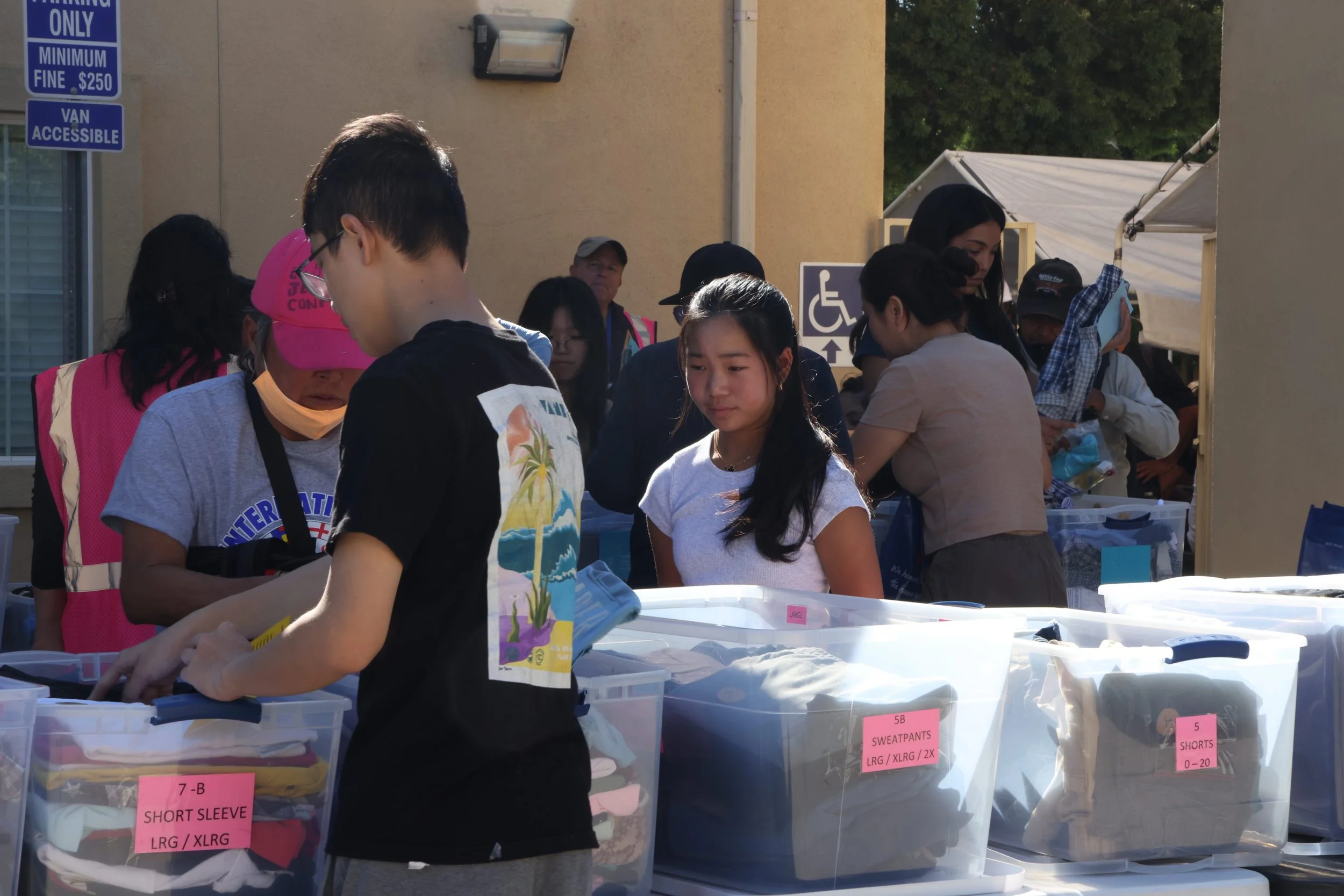Fashioning Hope: Clothing the Homeless
Photo: Brady Lee (Director of Photography)
In mid-November of 2023, Clothing The Homeless, a mobile clothing distribution system based in Orange County, assisted over one hundred individuals in need in four fruitful hours. Located in a humble community of Santa Ana, Clothing The Homeless aims to supply essential items to the street population, whom director Mitchell Raff respectfully refers to as VIPs. Behind a local food bank, volunteers—almost all high school and university students—gather to unload the CTH van, boldly stamped with two red helping hands, unmistakable to passersby. Despite the modest setting next to the food bank’s dumpster, volunteers and VIPs warm the cloudy fall weather through laughter, prayers, and greetings. The monthly distributions are open to anyone in need, and news of these events quickly spread among VIP communities through word of mouth and updates on the CTH website. "We believe in the dignity… of everyone," Raff emphasized, encouraging young volunteers to engage with the VIPs as equals, personally connect with them, and learn about their experiences to foster compassion.
Photo: Brady Lee (Director of Photography)
On Saturday the 11th, seven members from The Givers Guide joined twenty University of California Irvine students, students from University High School, and several other dedicated volunteers at the Santa Ana distribution center. Local institutions like Discovery Prep, Orange County School of the Arts, and Brownie Troops have contributed consistently to the Clothing the Homeless initiative. Earlier that morning, the founders of The Givers Guide, Meilin Shen, and Taite Nicholson, assisted Raff at a storage locker. Their task involved packing and organizing clothing donations into large plastic boxes, each labeled with the specific products with the corresponding gender. In addition to essential items like clothing and hygiene products, Clothing the Homeless provides accessories like colorful jewelry and safety items like whistles and ponchos. “You don't know what you will face out there. VIPs could get into fights with other people experiencing homelessness or face ridicule from civilians," Raff stated, revealing the unpredictable nature of life on the streets. Before the crowd of VIPs filed in, Raff and his wife guided the volunteers in thoroughly explaining the distribution process; the VIPs will line up in the yard, and helpers were assigned to aid them in filling out a paper indicating their specific needs. Once the paper is completed, another volunteer accompanies a single VIP and assists them in collecting the required items. Finally, the VIPs have the option to receive a prayer before leaving, honoring the Christian origins of the organization. With everyone aware of their roles, the volunteers put on their neon pink and yellow vests, fully prepared for the crowd's arrival.
Volunteers quickly acclimated to their tasks as the line of VIPs stretched around the corner of the street. VIPs followed their designated volunteer through the clothing bins to find their desired outfit. Thanks to donations, there were many options at the storage locker. Raff stresses that "donations of clothing and money and fundraisers'' are essential to keep his organization going. However, he also highlights that "coming out as a volunteer" is the most substantial support he could get. Raff explains that students who volunteer at CTH will be able to understand the reality of life outside of their protected "bubbles” in the dominantly affluent area of Orange County. Citizens of this city can become unaware that homelessness is prominent due to the highly luxurious areas blurring the image of five thousand unsheltered people. They may dwell under tunnels and bridges while expensive cars drive above. According to Raff, it's "crucial to address our issue in this difficult time after the pandemic," as many have tumbled into a financial crisis and are struggling to get back on foot. Most of the VIPs he encounters are men who are African American. The ratios of men to women he sees are four to one, respectively, an observation he is curious to understand. But disregarding gender or race, every VIP took only one of the hygiene items, and when volunteers asked if they wanted more, they would shake their heads to save necessities for the other VIP members. "They are a community," Raff explains, "some of them just had a lot of bad luck, but they still want to receive help and provide it." Through volunteering, individuals can gain a new perspective and understanding of the homeless challenges. By working together, communities can make a difference in the lives of those who need it most.
Photo: Brady Lee (Director of Photography)
After the last VIP parted from the volunteers with grateful words and blessings, Meilin and Taite returned to the storage lockers with Raff for an interview. Raff explained that he took the organization under his arms in 2016 when the initial founders of Journey Church went out of business due to a lack of financial support. The nonprofit organization provides and caters to the essential needs of VIPS, offering them vital supplies to navigate the challenges of their lives. Their primary focus is to make it very accessible and to ensure that they can easily access the supplies. Through partnerships, they specifically contribute by providing essential clothing items to enhance the well-being of those experiencing homelessness. During the years when COVID-19 spiked, CTH could not distribute clothing and other necessities to the VIPs, so they conducted "Ninja Runs” in which they filled backpacks with the necessary supplies and drove to areas including Santa Ana, Costa Mesa, Anaheim, etc., to distribute directly to the VIPs.
Due to Santa Ana being a more homeless-populated city, Clothing the Homeless is a considerable contributor to the overall lowering of the city's homeless population by 44 percent from 2019 to 2022. Since 2019, CTH initially started by helping 380 and 758 to 471 and 1048 women and men, respectively, in 2022. This is a significant increase in how the organization impacts the community while lowering the homeless population in the city. Furthermore, not only does this organization help people without housing, but it also promotes attention to volunteers. With 651 volunteers in 2023, CTH is building and expanding their impact. Looking forward, Clothing The Homeless aspires to be an even more resourceful center for the community.
Clothing the Homeless Team with Director Mitchell Raff in the center and his wife with her arm around him (Photo from CTH website)
Through their mobile clothing distribution system, composed of volunteers dedicated to assisting others, CTH assures all donations go directly to help people who are all too familiar with life without consistent shelter. Clothing the Homeless claims the mission of meeting the needs of homeless men and women with clothing and necessities for life on the streets while enduring different seasons and weather. While other clothing distributors make it challenging for people to receive clothing by requiring vouchers and are far away from the recipient's location, CTH partners with other front-line organizations and schools to conduct volunteering events and clothing drives. However, it is no surprise that working first-hand with people on the poverty line isn’t without its challenges, whether it be not receiving enough clothing donations specifically for women’s clothing or finding solutions to violence on the streets. Director Raff addresses this problem by stating that "Homeless people are always going to be targeted whether it's from outsiders walking on streets or even between themselves.” While enduring judgmental glares and spiteful comments from people passing by, inhabitants of the streets have mental health issues perpetuated by isolation. It is not uncommon for the days of VIPS to be spent feeling hopeless. Unaddressed psychiatric and substance abuse disorders, either developed during their time on the streets or which contributed to their unstable lifestyle, go without treatment or awareness. CTH's unique approach prioritizes expressing genuine care and compassion towards the homeless population. This stands in contrast to how others typically treat them. Raff emphasizes that this attention and care can impact the individuals they serve, “giving them something that they usually don't get, and that's attention. We are showing them that we care, and that's very different from how other people treat them."



